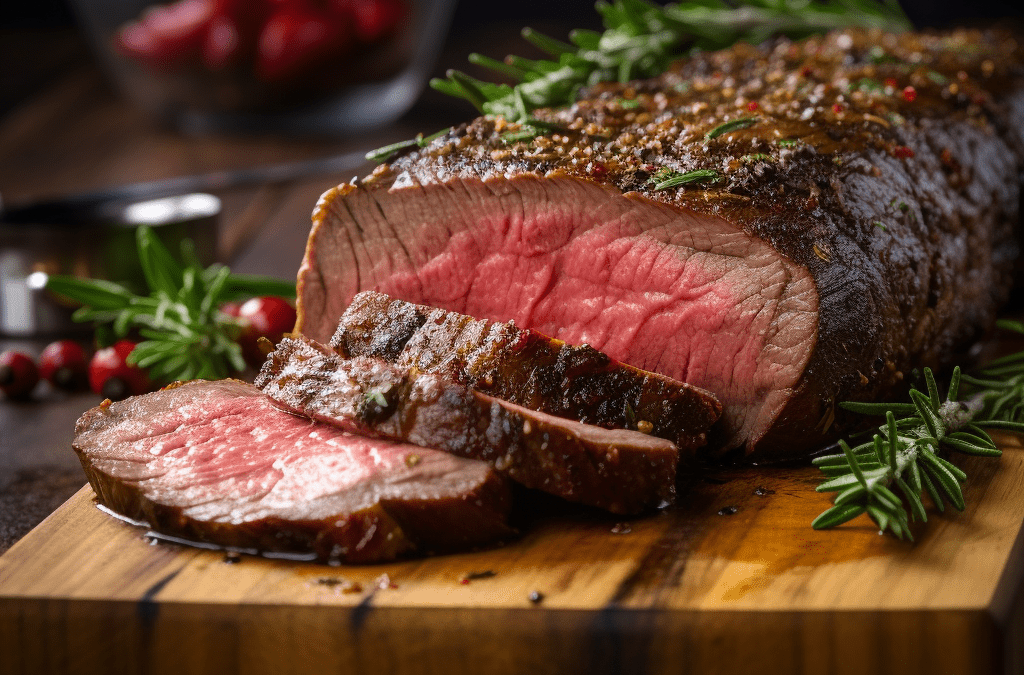If you’ve ever visited a Brazilian steakhouse, you might have noticed a uniquely delicious cut of beef called picanha. This Brazilian favorite, also known as the rump cap or top sirloin cap, is renowned for its rich flavor and juicy tenderness, thanks in part to its signature fat cap. This guide will help you bring the mouth watering experience of Brazilian steakhouses to your home kitchen by teaching you how to cook picanha perfectly.
Ready to impress your family and friends with your culinary skills? Let’s get started!
Table of Contents
- What is Picanha?
- Choosing the Right Picanha
- Preparing Picanha for Cooking
- Seasoning Picanha
- Cooking Methods for Picanha
- Resting and Slicing Picanha
- Serving Suggestions
- Common Mistakes to Avoid
- Conclusion
What is Picanha?
Picanha is a beloved cut of beef that hails from the rump region of the cow. Known by various names such as rump cover, rump cap, or top sirloin cap, picanha boasts a unique blend of tenderness and flavor that makes it a standout. One of the defining features of picanha is its thick fat cap, which bastes the meat as it cooks, infusing it with rich, succulent flavors.
In Brazilian steakhouses, picanha is often skewered and grilled over open flames, creating a crispy, caramelized exterior and a juicy, tender interior. The fat cap plays a crucial role in this process, rendering it down to add flavor and moisture to the meat. Whether you’re enjoying it at a churrascaria or cooking it at home, picanha is sure to be a crowd-pleaser.

how to cook picanha
How to Choose the Right Picanha
Selecting a high-quality picanha is the first step toward culinary success. When you’re at the butcher or supermarket, look for a cut that has a generous fat cap—this is key to achieving the perfect flavor and texture. The fat cap should be at least 1/4 inch thick and cover the entire top of the meat.
Size
Ideally, you want a cut that weighs between 2 to 3 pounds. Anything larger might include parts of the tougher sirloin, which you want to avoid.
Appearance
Check for a uniform shape and a bright red color in the meat, indicating freshness.
Don’t be shy about asking your butcher for a specific cut if you don’t see what you’re looking for—most are happy to help.
Preparing Picanha for Cooking
Before you start cooking, it’s crucial to prepare your picanha properly. First, let the meat come to room temperature for about 30 minutes. This helps ensure even cooking and a tender result.
Next, gather your tools: a sharp knife, a sturdy cutting board, metal skewers, a cast iron skillet, and a charcoal grill. Each of these items plays a vital role in the cooking process. The sharp knife and cutting board are essential for trimming and scoring the fat cap, which helps the fat render and crisp up beautifully. The metal skewers are perfect for grilling, while the cast iron skillet is ideal for searing the meat.
Use your sharp knife to trim any excess fat from the sides of the picanha, but be careful not to remove too much—you want to keep that flavorful fat cap intact. Then, score the fat cap by making shallow cuts in a crisscross pattern. This allows the fat to render more evenly and helps to create a crispy, golden crust.
Seasoning Picanha
Seasoning picanha steak is delightfully simple, yet it makes all the difference in the final dish. Start with the basics: generously sprinkle kosher salt and freshly ground black pepper all over the meat. The salt will draw out the natural flavors of the beef, while the pepper adds a subtle kick.
For those who like to experiment, you can try marinating the picanha. A basic marinade might include olive oil, garlic, and a splash of red wine vinegar. Let the meat sit in the marinade for at least an hour, or overnight if you have the time. This will infuse the beef with additional layers of flavor.
Optional seasoning ideas include a sprinkle of smoked paprika for a touch of smokiness or a dusting of chili powder if you prefer a bit of heat. No matter what seasoning route you choose, remember that the goal is to enhance the natural taste of the picanha without overpowering it.

3 Cooking Methods for Picanha
Here are 3 different cooking methods for Picanha:
1. Grilling on a Charcoal Grill
To achieve the perfect picanha, start by preparing your charcoal grill. You want a high, consistent heat to sear the meat and render the fat. Light the charcoal and let it burn until it’s covered in a fine gray ash. Arrange the coals to create a two-zone fire: a hot side for searing and a cooler side for finishing the cooking.
Cut the picanha into thick slices, about 2-3 inches wide. Skewer the pieces in a horseshoe shape, with the fat side facing out. This helps the fat render and baste the meat as it cooks. Place the skewers on the hot side of the grill to sear the fat cap until it’s crispy and golden brown.
Once the fat is seared, move the skewers to the cooler side of the grill. Cook for about 15-20 minutes, turning occasionally to ensure even cooking. Aim for an internal temperature of 130°F (54°C) for medium-rare. Remember, cooking times may vary based on the thickness of your cuts and the heat of your grill.
Use a meat thermometer to check the internal temperature. This is crucial to avoid overcooking or undercooking. For a medium-rare picanha, aim for 130°F (54°C). Remove the skewers from the grill and let them rest for about 10 minutes before slicing.
2. Cooking in a Cast Iron Skillet
Preheat your cast iron skillet over high heat until it’s smoking hot. A hot skillet is essential for searing the fat cap and creating a beautiful crust on the meat.
Place the picanha fat side down in the skillet. Sear for about 5-7 minutes until the fat is crispy and golden. Turn the picanha and sear the other sides for 2-3 minutes each.
If your picanha is thick, you might need to finish it in the oven. Preheat the oven to 375°F (190°C). Transfer the skillet to the oven and roast until the internal temperature reaches 130°F (54°C) for medium-rare. This should take about 10-15 minutes, depending on the thickness of the cut.
3. Roasting Picanha Steak
Preheat your oven to 375°F (190°C). Place the picanha on a roasting rack set inside a roasting pan. This setup ensures even heat circulation around the meat.
Roast the picanha for about 45-60 minutes, or until the internal temperature reaches 130°F (54°C) for medium-rare. Use a meat thermometer to check the temperature accurately.
Once the picanha reaches the desired temperature, remove it from the oven and let it rest for 10-15 minutes. Resting allows the juices to redistribute throughout the meat, making it tender and flavorful.
Resting and Slicing Picanha
Resting is a crucial step in cooking picanha. When the meat rests, the juices redistribute, resulting in a juicier and more flavorful steak. Rest the meat for at least 10 minutes before slicing.
To slice picanha, use a sharp knife and cut against the grain. Slicing against the grain breaks up the muscle fibers, making each bite tender and easy to chew. Cut the picanha into thin slices for the best texture and flavor.
Serving Suggestions
- Pair your perfectly cooked picanha with traditional Brazilian sides like farofa (toasted cassava flour), chimichurri sauce, rice, and black beans. These sides complement the rich, savory flavors of the picanha and create a well-rounded meal.
- For a true Brazilian experience, serve your picanha with a caipirinha, Brazil’s national cocktail made with cachaça, lime, and sugar. Alternatively, a red wine like Malbec or Cabernet Sauvignon pairs beautifully with the rich, beefy flavors of picanha.

Common Mistakes to Avoid
- To avoid overcooking or undercooking, always use a meat thermometer to check the internal temperature. Aim for 130°F (54°C) for medium-rare. Overcooked picanha can be tough, while undercooked meat can be chewy and unappetizing.
- Skipping the resting step can lead to dry, less flavorful meat. Always rest your picanha for at least 10 minutes before slicing to retain the juices.
- Slicing with the grain results in tougher, chewier pieces of meat. Always slice against the grain to ensure tender, easy-to-chew slices.
Conclusion
In this guide, we’ve explored everything you need to know about how to cook picanha, from selecting the perfect cut to mastering various cooking methods. Remember, the key to perfect picanha is in the preparation, seasoning, and proper cooking techniques. Why not give it a try?
FAQs
- What is the best way to cook a picanha?
The best way to cook picanha is by grilling it on a charcoal grill, searing the fat side first, then cooking it to medium-rare. This method enhances its flavor and tenderness.
- Is picanha tender or tough?
Picanha is known for being tender and flavorful, especially when cooked correctly with its fat cap intact, which bastes the meat as it cooks.
- Is picanha better smoked or grilled?
Grilling is the preferred method for cooking picanha, as it creates a crispy, caramelized exterior while keeping the interior juicy and tender. However, smoking can also impart a unique flavor.
- How to cook picanha without a grill?
To cook picanha without a grill, sear it in a hot cast iron skillet, fat side down first, then finish in the oven at 375°F until it reaches the desired internal temperature.
- Should I salt a picanha before cooking?
Yes, generously salt the picanha before cooking. This enhances its natural flavors and helps create a delicious crust on the outside.
Buy Beef Picanha Roast online right now in USA →

About Christo Barnhoorn
Christo Barnhoorn, a seventh-generation rancher, carries a legacy of tradition and ambition from his upbringing on a South African sheep farm. Immersed in the practices of sheep farming, he developed a deep understanding of the industry. With a desire to expand his horizons, Christo moved to the United States and established his own ranch in New Mexico. There, he successfully combined his traditional knowledge with innovative practices, transforming his venture into a flourishing online meat retailer.
Related Articles


